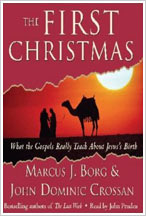The First Christmas
By Marcus J. Borg and John Dominic Crossan
Review By Casey Fedde
Categories: Bible Study, Jesus' Birth "O little town of Bethlehem…." There are many familiar Christmas carols joyously sharing the news of "our dear Savior's birth." When hearing these songs around Christmastime, we're reminded of the story of Jesus. But the nativity story we often cherish and retell might be different from others' stories because there are multiple, varying interpretations present in the New Testament of the Bible. It's a good thing those "glorious song[s] of old" omit the place of Jesus' conception. Otherwise, we might be singing, "O little town of Nazareth…."
 Why the disagreement on the place of Jesus' conception – and many other details surrounding his birth? There are two stories, two storytellers, two accounts in two separate books of the Bible. And there are two leading scholars, Marcus J. Borg and John Dominic Crossan, who unravel the nativity stories of Jesus in a fresh and surprising way in The First Christmas. Why the disagreement on the place of Jesus' conception – and many other details surrounding his birth? There are two stories, two storytellers, two accounts in two separate books of the Bible. And there are two leading scholars, Marcus J. Borg and John Dominic Crossan, who unravel the nativity stories of Jesus in a fresh and surprising way in The First Christmas.
Many are unaware of Matthew's and Luke's separate genealogies of Jesus. Neither story, as the authors point out, lends itself to being combined; however, both stories are often the product of a filter of tradition where they become "harmonized" and lose their "rich distinctiveness." It is the combination of their distinctiveness and details – complementary or not – that "is how we enter into the possibility of understanding what they [the nativity stories] meant in the first century and might still mean for communities of faith today."
But Borg and Crossan don't pit Matthew's genealogy of Jesus against Luke's. Their mission is not to establish fact or fiction, but rather to comment on the issues and controversies, and to reveal the parallels and meanings of the first Christmas. To do that, they divide and conquer, tackling both the historical and contemporary details of each account as well as the parabolic language in order to show how the stories speak to the lives of the people at the time in which they were written and to our lives as individuals.
The authors remind us that the Bible is literature written as a parable, and like all great parables, it's written for the purpose of conveying meaning, not factuality. They suggest that the nativity stories are each parabolic overtures or miniature versions of the succeeding gospels, Matthew and Luke. By removing the distraction of fact versus fable, we can instead focus on the stories' meanings.
Moving through the nativity stories, The First Christmas covers parable, overture, and context; the genealogy, conception, and birth; and themes – primarily light, fulfillment, and joy. (The chapter on light as a symbol in these stories is truly illuminating.) Exploring the nativity stories in Matthew and Luke expands the texts beyond their chapters, connecting them with other stories in the Bible, like the story of creation and Adam and Eve, and linking the New Testament to the Old Testament. There is even mention of a third nativity story in the book of Revelation! Most fascinating, something rarely taught in Sunday school, is the parallelism between Jesus and Caesar Augustus. Connecting the stories to Roman history creates a deep understanding of why these biblical texts were written, and impacts our modern-day interpretation and applicability of their message.
Similar to The Last Week, the authors' previous collaboration on Jesus, The First Christmas approaches Jesus' birth and early years much like his crucifixion and resurrection, creating a natural sequel – or prequel, if you will. Together, the two books form a bookend of Jesus. Since the nativity stories are not limited to Jesus' first week and are not told in the same day-by-day timeline as Holy Week, Good Friday, and Easter, this book focuses on the first Christmas, "what the gospels really teach about Jesus' birth."
There is no linear timeline in learning about the first Christmas. And The First Christmas is no family tree or literary photo album of Jesus' life. (The gospels don't even agree on the lineage of Jesus.) The book weaves through the first two chapters of both Matthew and Luke – with several detours through Greek translations, allusions to Roman imperial theology, and diatribes about "parabolic mathematics" – and finally reveals at the end of each chapter a clearer understanding of how and why the gospels shared their differing accounts of the nativity.
According to Borg and Crossan, "[T]he Christmas stories and the Bible as a whole – combine what we often separate, namely, religion and politics, spirituality and a passion for this world." It's through reading books about the Bible, like The First Christmas, that we learn more about the richness and power of the Bible, and how we can live by its message. |